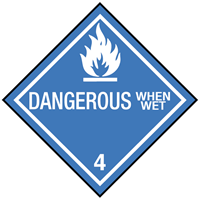
 Print
Print
Chemical Datasheet
CALCIUM |

|
Chemical Identifiers
| CAS Number |
UN/NA Number |
DOT Hazard Label |
USCG CHRIS Code |
|
|
|
|
|
| NIOSH Pocket Guide |
International Chem Safety Card |
|
none
|
|
NFPA 704
General Description
A silvery, soft metal that turns grayish white on exposure to air. Used in metallurgy.
Hazards
Reactivity Alerts
- Strong Reducing Agent
- Water-Reactive
- Pyrophoric
Air & Water Reactions
Pyrophoric ignites in air when finely divided, then burns with crimson flame [Merck 11th ed. 1989]. Calcium rapidly decomposes in water, the heat of reaction is sufficient that hydrolysis released hydrogen may ignite [Lab. Gov. Chemist 1966]. Pyrophoric hazard only exists when this material is in a powdered form. If the material is in large pieces, it is unlikely to burn or react strongly with water under normal conditions.
Fire Hazard
Excerpt from ERG Guide 138 [Substances - Water-Reactive (Emitting Flammable Gases)]:
Produce flammable gases on contact with water. May ignite on contact with water or moist air. Some react vigorously or explosively on contact with water. May be ignited by heat, sparks or flames. May re-ignite after fire is extinguished. Some are transported in highly flammable liquids. Runoff may create fire or explosion hazard. (ERG, 2024)
Health Hazard
Contact with eyes or skin produces caustic burns. (USCG, 1999)
Reactivity Profile
Boron trifluoride reacts with incandescence when heated with alkali metals or alkaline earth metals except magnesium [Merck 11th ed. 1989]. Calcium reacts violently with acids [Lab. Govt. Chemist 1965]. Finely divided calcium burns spontaneously in chlorine at elevated temperatures [Mellor 3:637, 638, 651 1946-47]. Finely divided or massive calcium burns spontaneously in fluorine at ordinary temperatures. It is incompatible with metal oxides, alkali metal hydroxides, chlorine fluorides, dinitrogen tetraoxide, and sulfur(with sulfur reacts explosively when ignited) [Bretherick, 5th Ed., 1995].
Belongs to the Following Reactive Group(s)
- Metals, Elemental and Powder, Active
Potentially Incompatible Absorbents
No information available.
Response Recommendations
Isolation and Evacuation
Excerpt from ERG Guide 138 [Substances - Water-Reactive (Emitting Flammable Gases)]:
IMMEDIATE PRECAUTIONARY MEASURE: Isolate spill or leak area in all directions for at least 50 meters (150 feet) for liquids and at least 25 meters (75 feet) for solids.
LARGE SPILL: Consider initial downwind evacuation for at least 300 meters (1000 feet).
FIRE: If tank, rail tank car or highway tank is involved in a fire, ISOLATE for 800 meters (1/2 mile) in all directions; also, consider initial evacuation for 800 meters (1/2 mile) in all directions. (ERG, 2024)
Firefighting
Excerpt from ERG Guide 138 [Substances - Water-Reactive (Emitting Flammable Gases)]:
DO NOT USE WATER OR FOAM.
SMALL FIRE: Dry chemical, soda ash, lime or sand.
LARGE FIRE: DRY sand, dry chemical, soda ash or lime or withdraw from area and let fire burn. If it can be done safely, move undamaged containers away from the area around the fire.
FIRE INVOLVING METALS OR POWDERS (ALUMINUM, LITHIUM, MAGNESIUM, ETC.): Use dry chemical, DRY sand, sodium chloride powder, graphite powder or class D extinguishers; in addition, for Lithium you may use Lith-X® powder or copper powder. Also, see ERG Guide 170.
FIRE INVOLVING TANKS, RAIL TANK CARS OR HIGHWAY TANKS: Fight fire from maximum distance or use unmanned master stream devices or monitor nozzles. Do not get water inside containers. Cool containers with flooding quantities of water until well after fire is out. Withdraw immediately in case of rising sound from venting safety devices or discoloration of tank. ALWAYS stay away from tanks in direct contact with flames. (ERG, 2024)
Non-Fire Response
Excerpt from ERG Guide 138 [Substances - Water-Reactive (Emitting Flammable Gases)]:
ELIMINATE all ignition sources (no smoking, flares, sparks or flames) from immediate area. Do not touch or walk through spilled material. Stop leak if you can do it without risk. Use water spray to reduce vapors or divert vapor cloud drift. Avoid allowing water runoff to contact spilled material. DO NOT GET WATER on spilled substance or inside containers.
SMALL SPILL: Cover with DRY earth, DRY sand or other non-combustible material followed with plastic sheet to minimize spreading or contact with rain. Dike for later disposal; do not apply water unless directed to do so.
POWDER SPILL: Cover powder spill with plastic sheet or tarp to minimize spreading and keep powder dry. DO NOT CLEAN-UP OR DISPOSE OF, EXCEPT UNDER SUPERVISION OF A SPECIALIST. (ERG, 2024)
Protective Clothing
Goggles and rubber gloves. (USCG, 1999)
DuPont Tychem® Suit Fabrics
No information available.
First Aid
Flush with water (USCG, 1999)
Physical Properties
Flash Point: data unavailable
Lower Explosive Limit (LEL): data unavailable
Upper Explosive Limit (UEL): data unavailable
Autoignition Temperature:
1454+-18°F
(USCG, 1999)
Melting Point:
1562°F
(USCG, 1999)
Vapor Pressure: data unavailable
Vapor Density (Relative to Air): data unavailable
Specific Gravity:
1.55
at 68°F
(USCG, 1999)
- Denser than water; will sink
Boiling Point:
2714°F
at 760 mmHg
(USCG, 1999)
Molecular Weight:
40.1
(USCG, 1999)
Water Solubility: data unavailable
Ionization Energy/Potential: data unavailable
IDLH: data unavailable
AEGLs (Acute Exposure Guideline Levels)
No AEGL information available.
ERPGs (Emergency Response Planning Guidelines)
No ERPG information available.
PACs (Protective Action Criteria)
No PAC information available.
Regulatory Information
EPA Consolidated List of Lists
No regulatory information available.
CISA Chemical Facility Anti-Terrorism Standards (CFATS)
No regulatory information available.
OSHA Process Safety Management (PSM) Standard List
No regulatory information available.
Alternate Chemical Names
- ATOMIC CALCIUM
- BLOOD-COAGULATION FACTOR IV
- CALCIUM
- CALCIUM ATOM
- CALCIUM ELEMENT
- CALCIUM METAL, CRYSTALLINE
- CALCIUM, METAL
- CALCIUM, METAL, [CRYSTALLINE]
- PRAVAL


 Print
Print
